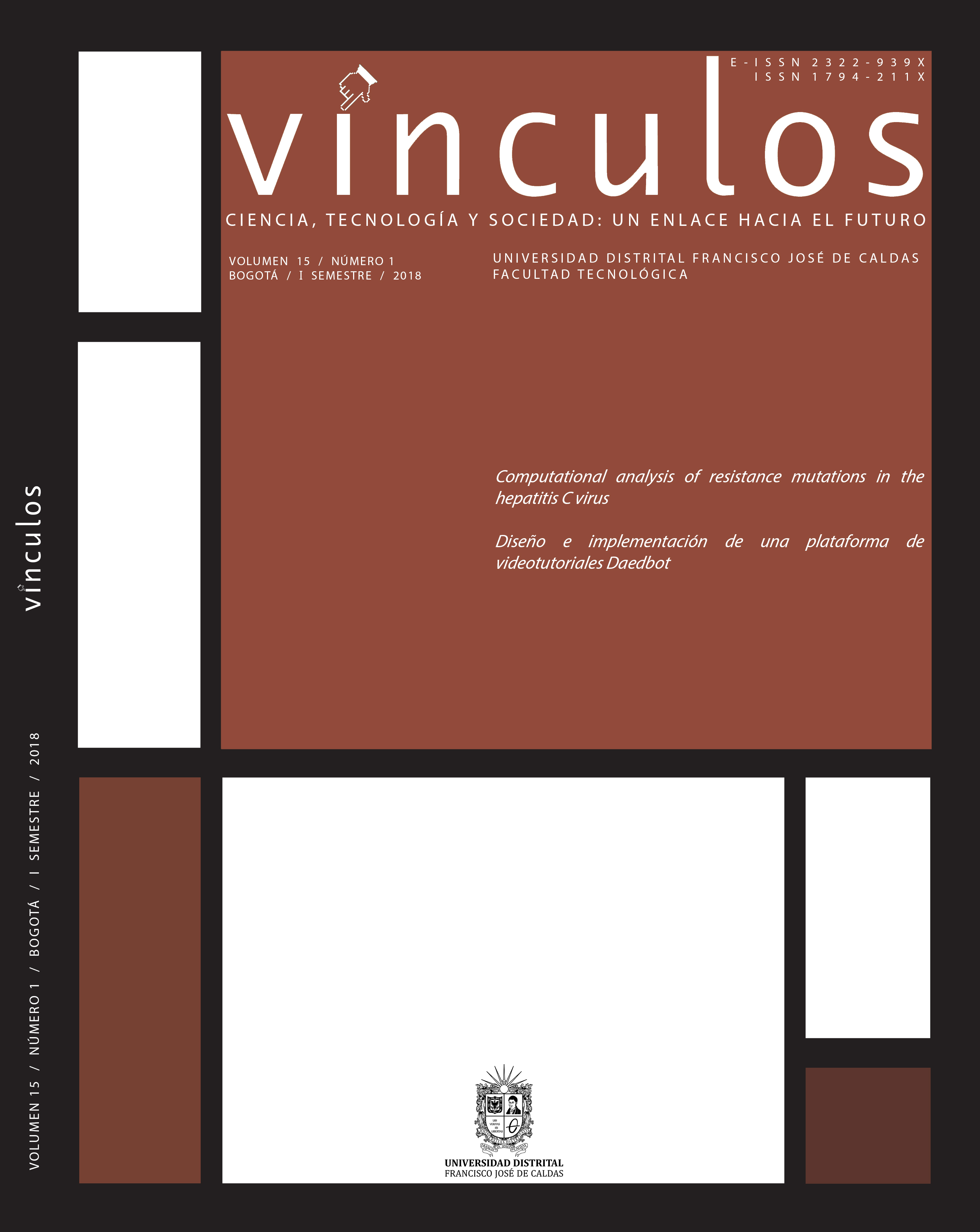DOI:
https://doi.org/10.14483/2322939X.13019Publicado:
2018-05-17Número:
Vol. 15 Núm. 1 (2018)Sección:
Investigación y DesarrolloDetección y corrección de propagaciones anómalas en radares meteorológicos
Detection and correction of anomal propagations in weather radars
Palabras clave:
anomalous propagation, weather radar, reflectivity, polarimetric variables (en).Palabras clave:
propagaciones anómalas, radar meteorológico, reflectividad, variables polarimétricas (es).Descargas
Resumen (es)
En este artículo se presentan los resultados del diseño de un modelo para la detección y corrección de propagaciones anómalas de los datos de un radar meteorológico en zonas ecuatoriales, específicamente en la geografía colombiana. Inicialmente se realizó la decodificación de los datos medidos por el radar, luego se realizó un análisis estadístico de los mismos, esta información permitió definir las variables que se utilizaron y la ponderación de cada una de ellas en el modelo desarrollado. Luego se diseñó el algoritmo de detección y corrección de dicho modelo. Finalmente se desarrolló una serie de pruebas que permitieron validar el adecuado funcionamiento del modelo obteniendo márgenes de error de hasta 4,67%.Resumen (en)
This paper presents the results of the design of a model for the detection and correction of anomalous propagation of a meteorological radar data in equatorial zones, specifically in the Colombian geography. Initially, the decoding of the data measure by the radar was made, then this data got a statistical analysis, this information allowed to define the variables that were used and the weighting of each of them in the developed model. Then the detection and correction algorithm of the model was designed. Finally, a series of tests was developed that allowed validating the proper functioning of the model obtaining margins of error up to 4.67%.
Referencias
About Radar: Enviroment Canadá, Agosto 2014. [En línea]. Disponible en: http://www.ec.gc.ca/meteo-weather/default.asp?lang=En&n=2B931828-1D.
J. R. Peter, A. Seed, P. Steinle, S. Rennie y M. Curtis, “A Bayesian methodology for detecting anomalous propagation in radar reflectivity observations”, The Centre for Australian Weather and Climate Research, Technical report No. 077, Diciembre 2014.
P. P. Alberoni, T. Andersson, P. Mezzasalma, D. B. Michelson y S. Nanni, “Use of the vertical reflectivity profile for identification of anomalous propagation”, Meteorological Applications, vol. 8, n°. 3, pp. 257-266, 2001.
C. Kessinger, S. Ellis, J. Van Andel, J. Yee y J. Hubbert, “The AP ground clutter mitigation scheme for the WSR-88D”, 21st International Conference on Interactive Information Processing Systems (IIPS) for Meteorology, Oceanography, and Hydrology, 2005.
M. Smith y J. A. Steiner, “Use of three-dimensional reflectivity structure for automated detection and removal of nonprecipitating echoes in radar data”, Journal of Atmospheric and Oceanic Technology, vol. 19, n°. 5, pp. 673-686, 2002.
J. J. Gourley, P. Tabary y J. P. du Chatelet, “A fuzzy logic algorithm for the separation of precipitating from nonprecipitating echoes using polarimetric radar observations”, Journal of Atmospheric and Oceanic Technology, vol. 24, n°. 8, pp. 1439-1451, Agosto 2007.
J. C. Hubbert, M. Dixon, S. M. Ellis y G. Meymaris, “Weather radar ground clutter. Part I: Identification, Modeling, and Simulation”, Journal of Atmospheric and Oceanic Technology, vol. 26, n°. 7, pp. 1165-1180, Julio 2009.
C. Kessinger, S. Ellis y J. Van Andel, “The Radar Echo Classifier: A Fuzzy Logic Algorithm for the WSR-88D”, 3rd Conference on Artificial Intelligence Applications to the Environmental Science, Febrero 2003.
M. Grecu y W. F. Krajewski, “An Efficient Methodology for Detection of Anomalous Propagation Echoes in Radar Reflectivity Data Using Neural Networks”, Journal of Atmospheric and Oceanic Technology, vol 17, n°. 2, pp. 121-129, Febrero 2000.
W. F. Krajewski y B. Vignal, “Evaluation of Anomalous Propagation Echo Detection in WSR-88D Data: A Large Sample Case Study”, Journal of Atmospheric and Oceanic Technology, vol. 18, n°. 5, pp. 807-814, Mayo 2001.
V. Lakshmanan, A. Fritz, T. Smith, K. Hondl y G. Stumpf, “An Automated Technique to Quality Control Radar Reflectivity Data”, Journal of Atmospheric and Oceanic Technology, vol. 46, n°. 3, pp. 288-305, Marzo 2007.
S. Moszkowicz, G. J. Ciach y W. F. Krajewski, “Statistical Detection of Anomalous Propagation in Radar Reflectivity Patterns”, Journal of Atmospheric and Oceanic Technology, vol. 11, n°. 4, pp. 1026-1034, Agosto 1994.
M. A. Rico-Ramirez y I. D. Cluckie, “Classification of Ground Clutter and Anomalous Propagation Using Dual-Polarization Weather Radar”, IEEE Transactions on Geoscience and Remote Sensing, vol. 46, n°. 7, pp. 1892-1904, Julio 2008.
A. F. Hurtado y O. J. Mesa, “Reanalysis of monthly precipitation fields in Colombian territory”, Revista DYNA, vol. 81, n°. 186, pp. 251–258, 2014.
Curso de Posgrado de Climatología Aplicada: El radar meteorológico y sus aplicaciones hidrológicas (4), Centre de Recerca Aplicada en Hidrometereología (CRAHI), Universidad Politécnica de Cataluña. [En línea]. Disponible en:http://www.crahi.upc.edu/index.php?option=com_content&view=article&id=110%3Acurs-radar&catid=39&Itemid=109&lang=es
R. Sánchez-Diezma, “Optimización de la medida de lluvia por radar meteorológico para su aplicación hidrológica”, tesis Ph.D., Departamento de Ingeniería Hidráulica Marítima y Ambiental, Universidad Politécnica de Cataluña, Barcelona, España, 2001.
Curso de Posgrado de Climatología Aplicada: El radar meteorológico y sus aplicaciones hidrológicas (6), Centre de Recerca Aplicada en Hidrometereología (CRAHI), Universidad Politécnica de Cataluña. [En línea]. Disponible en:http://www.crahi.upc.edu/index.php?option=com_content&view=article&id=112%3Acurs-radar&catid=39&Itemid=109&lang=es
A. V. Ryzhkov, S.E. Giangrande, V. M. Melnikov y T. J. Schuur, “Calibration Issues of Dual-Polarization Radar Measurements”, Journal of atmospheric and ocean technology, vol. 22, n°. 8, pp.1138-1155, Agosto 2005.
T. Schuur, A. Ryzhkov y P. Heinselman, “Observations and classification of echoes with the polarimetric WSR-88D radar” NOAA National Severe Storms Laboratory Tech Report, Norman, Oklahoma, USA, Octubre 2003.
H. Park, A. V. Ryzhkov, D. S. Zrnic y K.E.Kim, “The Hydrometeor Classification Algorithm for the Polarimetric WSR-88D: Description and Application to an MCS”, Weather and Forecasting vol. 24. pp. 730-748, 2008, https://doi.org/10.1175/2008WAF2222205.1
Dual-pol Applications Non-Precipitation Echoes, National Weather Service (Warning Decision Training Division). [En línea]. Disponible en:http://training.weather.gov/wdtd/courses/dualpol/Applications/nonPrecip/player.html
G. Sánchez, “Técnicas participativas para la planeación” México: Fundación ICA, AC., 2003, capítulo 16: Jerarquización Analítica, pp. 167-182.
T. L. Saaty, “Decision Making for Leaders: The Analytic Hierarchy Process for Decisions in a Complex World”, Pittsburgh, Pennsylvania: RWS Publications, 1 de mayo de 1999.
Técnicas de filtrado, Universidad de Murcia. [En línea]. Disponible en:http://www.um.es/geograf/sigmur/teledet/tema06.pdf


2.png)



